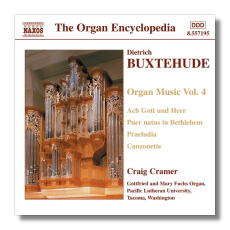
The Internet's Premier Classical Music Source
Related Links
- Buxtehude Reviews
- Latest Reviews
- More Reviews
-
By Composer
-
Collections
DVD & Blu-ray
Books
Concert Reviews
Articles/Interviews
Software
Audio
Search Amazon
Recommended Links
Site News
 CD Review
CD Review
Dietrich Buxtehude

Organ Music - Volume 4
- Praeludium in D minor, BuxWV 140
- Nun bitten wir den heiligen Geist, BuxWV 208
- Komm, heiliger Geist, Herre Gott, BuxWV 200
- Herr Jesu Christ, ich weiss gar wohl, BuxWV 193
- Canzonetta in G Major, BuxWV 171
- Ach Gott und Herr, BuxWV 177 (Versions 1 & 2)
- Danket dem Herren, BuxWV 181 (Versions 1-3)
- Canzonetta in D minor, BuxWV 168
- Praeludium in E minor, BuxWV 143
- Gelobet seist du, Jesu Christ, BuxWV 189
- Nun komm, der Heiden Heiland, BuxWV 211
- Puer natus in Bethlehem, BuxWV 217
- Canzonetta in E minor, BuxWV 169
- Lobt Gott, ihr Christen allzugleich, BuxWV 202
- Es spricht der unweisen Mund wohl, BuxWV 187
- Toccata in D minor, BuxWV 155
Craig Cramer, organ
Naxos 8.557195 64:09 Recorded on the Gottfried and Mary Fuchs Organ, Pacific Lutheran University, Tacoma, Washington, 31 August 2003
Comparisons: Saorgin/Harmonia Mundi, Bryndorf/Dacapo
Naxos initiated its excellent Buxtehude organ series in 2001 and has now reached the 4th volume. To date, each volume has been performed by a different organist, and only modern organs are employed. This approach differs strongly with Dacapo's on-going Buxtehude series where Bine Bryndorf is the sole organist and plays on historical instruments.
Craig Cramer continues the high quality of the previous Naxos volumes. Cramer is an American organist who earned the Doctor of Musical Arts degree in organ performance from the Eastman School of Music and is currently a Professor of Organ at the University of Notre Dame in Indiana. He has performed throughout the United States and Europe, his discography ranging from Bach on historical organs to 20th century fare.
A little historical perspective is in order. Buxtehude's organ music represents the pinnacle of the "Stylus Phantasticus". In the early 1600's, composers such as Heinrich Scheidemann and Samuel Scheidt ushered in a greater compositional freedom that deviated significantly from the rigidity of the then-exisiting regimen. These freedoms were most prevalent in the Praeludium and Toccata, two compositional types involving an alternating pattern of 'free-form' sections framing multiple fugues. Buxtehude perfected this new style, giving the 'free-form' sections an expansiveness, variety of expression, and all-encompassing power surpassing all previous composers.
On Cramer's program, we are offered four works in the 'free-form' style. The remainder of the program consists of three Canzonetta and ten Chorales. The Canzonetta is a contrapuntal work consisting of a series of fugues displaying stretto, contrary motion, and inversion; rhythmic motion tends to be lively, and the detail of musical lines illuminating. The Chorale is based on religious text and conforms to the patterns established many decades earlier.
Leaving aside the Praeludium and Toccata tracks for the moment, Cramer's performances are exceptional. He gives the Chorales a reverential treatment, but the music never sags or becomes somber due to a fine rhythmic vitality. Also, the registrations are absolutely delicious, and the readings very comforting. Even more impressive is each Canzonetta where Cramer displays a wonderful elasticity of expression and pacing.
Cramer is not as successful in the 'free-form' works that are best played with great strength, drive, and excitement. I think it fair to say that Cramer is somewhat polite in his interpretations; switch to Saorgin or Bryndorf and the music soars with a sense of reckless abandon. An additional detriment for Cramer is that the sonics are rather compressed. Each musical line is drawn to the center of the soundstage, a condition representing a significant obstacle to all-encompassing waves of sound.
The organ, built by Paul Fritts and Company in 1999, is a major highight of the disc. It is a large 3-manual instrument constructed in baroque fashion in Keller temperament and with 15 reed stops. Although not historical, it is the next best thing. Cramer's registrations are not listed, but the organ's specifications are in the CD booklet. I should also relate that the booklet notes are splendid, offering excellent descriptions of the different types of music on the disc.
Don's Conclusions: Volume 4 is a very fine recording. Yes, Cramer is not a whirlwind in the 'free-form' works, but his rhythmic elasticity and exceptional registrations do win the day. Given the low Naxos price, I give the recording a hearty recommendation. As for alternatives, the exceptional Saorgin box-set is unfortunately out of print at this time, but the three volumes released so far in the Bine Bryndorf series are readily available. The main consideration is that Buxtehude's organ music is one of the glories of the Baroque period, and readers not familiar with this body of works are advised to investigate it and reap the tremendous rewards.
Copyright © 2005/2006, Don Satz




















